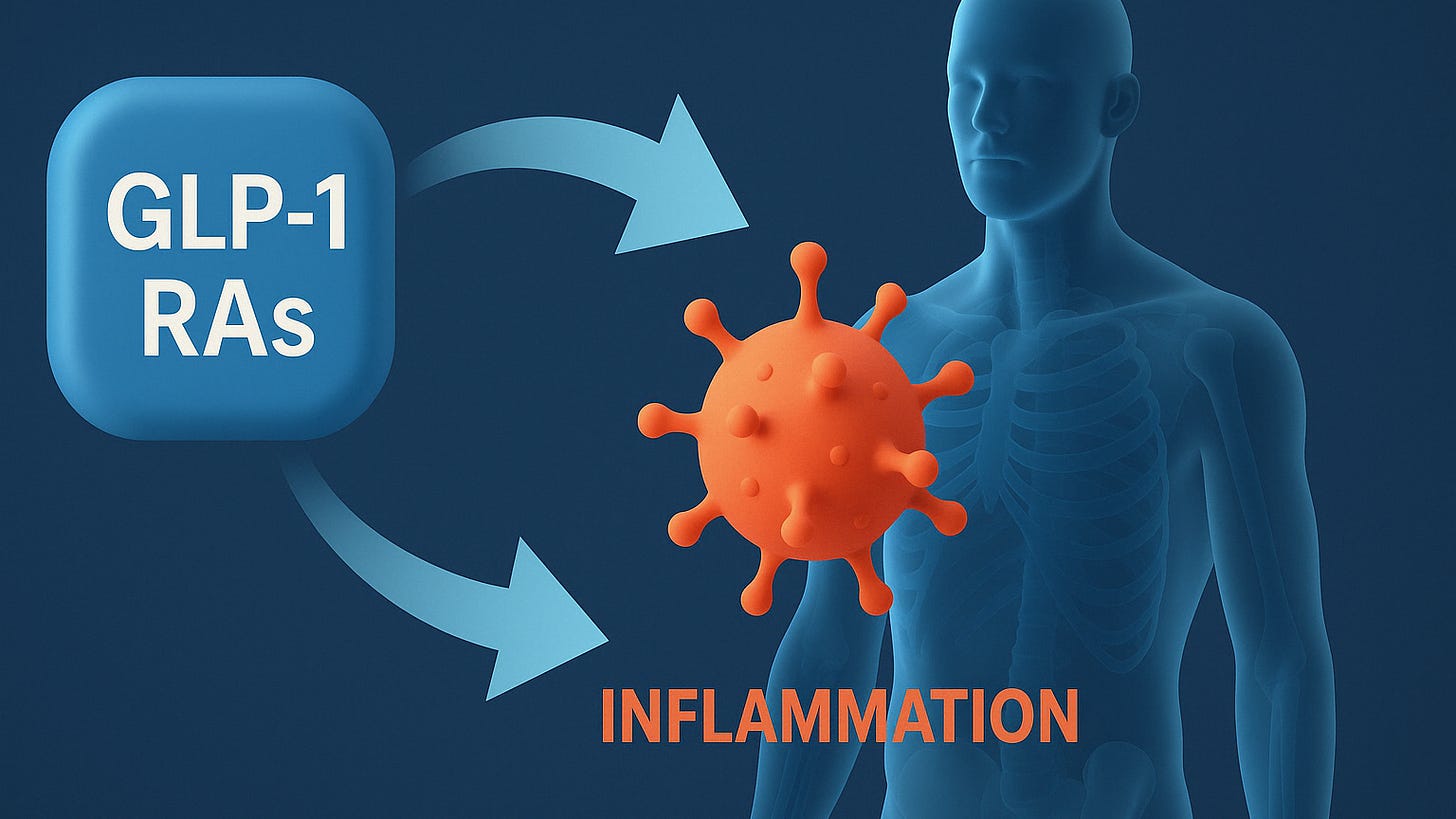Glucagon-like peptide-1 receptor agonists (GLP-1 RAs) like semaglutide (Ozempic/Wegovy) and liraglutide (Victoza/Saxenda) were built for diabetes and obesity—but they’re increasingly being studied for brain health and systemic inflammation. Below is a concise, evidence-based tour of what we know (and don’t know) so far.
Why GLP-1s are Biologically Plausible for Alzheimer’s
Beyond lowering glucose and weight, GLP-1 signaling appears to:
Improve insulin signaling in the brain
Dampen neuroinflammation (microglial activation)
Reduce oxidative stress
Interact with amyloid-β and tau pathways in preclinical models
Recent peer-reviewed reviews synthesize these mechanisms and frame GLP-1s as potential “multi-target” neuroprotective agents rather than single-pathway drugs.
Human Evidence: Dementia/Alzheimer’s Outcomes
Observational & Emulated-Trial data (signal of benefit)
Large real-world datasets now associate GLP-1 use with lower dementia risk compared with other antidiabetic drugs. For example, a 2025 JAMA Network Open cohort found semaglutide/tirzepatide users had lower risks of dementia, stroke, and all-cause mortality; other analyses (including Journal of Alzheimer’s Disease and JAMA Neurology) similarly report reduced incident dementia with GLP-1 Receptor Agonists as a class. These studies can’t prove causality, but the signal is consistent.
Randomized trials (direct AD studies)
Liraglutide (ELAD Phase 2b): In people with mild AD, 12 months of liraglutide slowed brain atrophy (MRI) and was associated with an ~18% slower cognitive decline versus placebo—encouraging but still preliminary and not yet a practice-changing Phase 3 outcome. Results were presented at AAIC 2024 and summarized by multiple outlets.
Semaglutide (EVOKE / EVOKE+ Phase 3): The first large, double-blind trials testing whether oral semaglutide modifies early symptomatic AD are ongoing; design papers were published in 2025. Top-line results are anticipated in late 2025.
Bottom line: Human RCT evidence is emerging (positive MRI/cognition signals with liraglutide in Phase 2b); the definitive verdict awaits the semaglutide Phase 3 readouts.
GLP-1s and hs-CRP: How Much Do They Lower Inflammation?
hs-CRP is a widely used biomarker of systemic inflammation and cardiovascular risk. Multiple randomized analyses show GLP-1s—especially semaglutide—produce meaningful hs-CRP reductions:
STEP 1/2/3 (weight-management trials): Semaglutide 2.4 mg weekly reduced CRP by ~39–44% vs. placebo at 68 weeks; reductions appeared early and across glycemic/BMI strata.
SUSTAIN & PIONEER pooled analyses (T2D): Semaglutide lowered hs-CRP vs comparators; mediation analyses suggest part of the effect is independent of weight/HbA1c.
SELECT (cardiovascular outcomes in people with prior CVD and overweight/obesity): Semaglutide reduced major CV events by 20%; exploratory analyses show hs-CRP fell substantially, with reductions evident by week 4—before large weight changes—suggesting a direct anti-inflammatory component.
Clinical meaning: A 30–45% hs-CRP reduction is common with higher-dose semaglutide. In some trials, early, weight-independent changes point to intrinsic anti-inflammatory action—an appealing feature for vascular brain protection.
How Might Inflammation Tie to Alzheimer’s Risk?
Vascular and systemic inflammation accelerate small-vessel disease, blood-brain barrier injury, and neuroinflammation — all implicated in cognitive decline. Observational links between GLP-1 exposure, lower hs-CRP, and fewer cerebrovascular/neurodegenerative events fit this biology, although only dedicated AD trials can confirm true disease modification.
Safety, Suitability, and Practical Notes
Common adverse effects: GI upset, nausea, constipation; risk of gallbladder disease; rare pancreatitis. Dose titration helps tolerability. (Consult the product label and your clinician.)
Older/lean adults: Monitor lean-mass and protein intake; pair with resistance training to reduce sarcopenia risk during weight loss.
Lipids and CV risk: Benefits in established CVD (SELECT) are robust; hs-CRP improvements may contribute independent of LDL changes.
APOE4 considerations: Human subgroup evidence by APOE genotype is limited. Until Phase 3 data read out, assume uncertain genotype-specific effects.
What to Watch Next
EVOKE / EVOKE+ (semaglutide, early AD): Top-line readouts expected in late 2025; these will clarify whether GLP-1s truly slow clinical progression in early AD. BrightFocus Foundation
Additional Phase 2/3 programs: Parallel GLP-1 and dual-agonist studies (e.g., tirzepatide) are exploring cognition, imaging, and fluid biomarkers.
Take-Home
Signal for dementia/AD risk reduction: Consistent across multiple large observational analyses; encouraging but not conclusive.
Robust hs-CRP lowering: Semaglutide repeatedly cuts hs-CRP ~30–45% in RCTs, with early, partly weight-independent effects—plausibly relevant to brain-vascular health.
Definitive AD answers: Await Phase 3 semaglutide results; the liraglutide Phase 2b MRI/cognition findings are promising but preliminary.
Key Sources (selection)
Cummings JL et al. EVOKE/EVOKE+ design (Phase 3 semaglutide in early AD). Alzheimer’s Research & Therapy, 2025. BioMed Central
Lin HT et al. GLP-1RAs and risk of dementia/stroke/mortality (cohort). JAMA Network Open, 2025. JAMA Network
Wang W et al. Semaglutide and first-time AD diagnosis (observational). Alzheimer’s & Dementia, 2024. alz-journals.onlinelibrary.wiley.com
Verma S et al. CRP reductions with semaglutide in STEP trials (RCTs). eClinicalMedicine (The Lancet), 2022/2023. PubMed
Mosenzon O et al. hs-CRP lowering across SUSTAIN/PIONEER (meta-analysis of RCTs). Diabetes Obes Metab, 2022 (open-access). PubMed Central
Plutzky J et al. SELECT: semaglutide, hs-CRP, and early CV benefits. Atherosclerosis, 2024; ADA Meeting summary, 2024. atherosclerosis-journal.comADA Meeting News
AAIC 2024 release: Liraglutide Phase 2b MRI and cognition signals. AAIC 2026
This article summarizes research and is not medical advice. If you’re considering GLP-1 therapy primarily for inflammation or brain risk reduction (especially if you’re lean or APOE4/4), partner closely with your clinician to weigh benefits, side-effects, nutrition/lean-mass protection, and cost/coverage.


Karin, I love your new Substack. Great info but I haven't found any information on dosing for AD prevention. Is there any information out there? I've been "micro-dosing" 10-15cc once per week. Of course, there's no way to determine it's efficacy. Is there an info or anecdotal info out there?